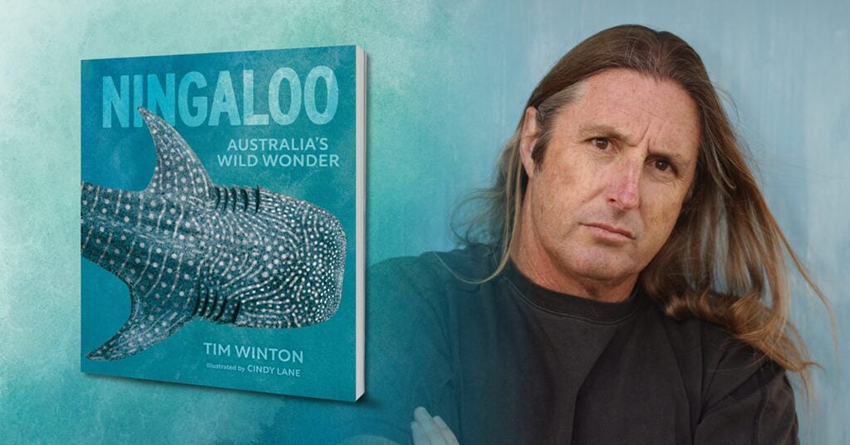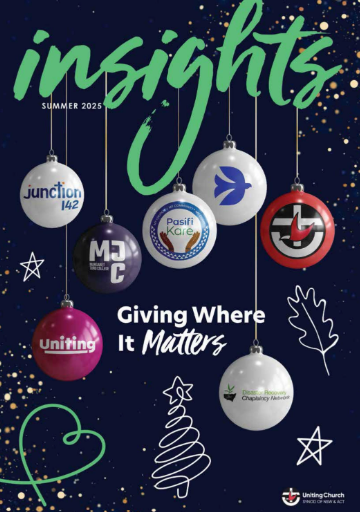Review: Ningaloo: Australia’s Wild Wonder, Tim Winton and Cindy Lane, Fremantle Press
Tim Winton is well known for his passion for the marine environments of Western Australia, through his fiction and his conservation work, for which he has been awarded an Order of Australia. In this book for young readers he, along with illustrator Cindy Lane, shares his passion for Ningaloo, an area of rugged beauty and ecological significance half-way up Western Australia’s coastline (about 1200 km from Perth, about the distance from Sydney to Bundaberg).
Winton introduced ABC viewers to this area two year ago in a fine documentary series; in those images, aerial shots show a painterly landscape – in this book, Lane’s series of watercolours, digitally stitched together, appropriately convey the colours, while both illustrations and text explain the richness of the wildlife.
The area, described by Winton as ‘desert with its feet in the sea’, consists of three key geological features – the Ningaloo reef, which stretches 200 km, the Cape Range and Exmouth Gulf, which is 50 times bigger than Sydney Harbour.
The reef is a snorkeller’s paradise because it is accessible simply by stepping off the beach. It’s rich with sea life, as two currents meet there. Nutrients flow from the south, and plankton thrives, in turn feeding significant, rare gatherings of whale sharks. Manta rays and whales also visit.
The current reef is only the latest in a series – the cape is a giant coral graveyard, raised by tectonic shifts. As you walk inland from the beach there are a series of fossil reefs, each older (and higher) than the last. The peninsula is largely limestone, which typically hosts caves, and in them are rare, eyeless fish and insects. A long time ago, rainforest covered the cape; now the water table has receded below the scorched earth, and the odd fig tree sends its roots deep into the subterranean, still-humid world.
Exmouth Gulf, which in an earlier, shallower iteration was a feasting place for local First Nations people, is significant for its seagrass beds, supporting dugongs, and mangroves supporting all manner of slippery, armoured and feathered wildlife, including curlews, which jet in from Russia each year, and juvenile fish which hide from predators amongst the trees.
The relatively extensive book has vivid illustrations of the various habitats and inhabitants: mangroves, reefs, caves, seagrass beds, sharks, turtles, snakes and rock wallabies that were widespread but are now confined largely to the cape after the disaster of colonisation.
In 2011 the Cape Range and Ningaloo Reef were listed as World Heritage areas, and they are national parks. However Exmouth Gulf remains unprotected, and this deficiency is one of the reasons for Winton’s promotion of the area. Indigenous culture insists on the importance of interconnections, and Winton describes the area as like an emu’s foot – the three toes (reef, cape, gulf) all give balance to the area. Without all three protected, things could become unbalanced.
This is even more important considering climate change, which affects coral reefs significantly. (While its unique geology means it is better placed than the Great Barrier Reef, bleaching is still a growing danger.) Even the caves here are threatened, as sea level rise will contaminate the freshwater lens in the caves with seawater.

Like other places in WA, the area is threatened by rapacious mineral extraction, which requires huge coastal infrastructure, partly so the minerals can simply be shipped off to China (the reason, one assumes, why the WA government has not yet protected the gulf). There is also, perhaps, a danger that publicising the area will increase tourism, which is often a mixed blessing: the area probably doesn’t need every other retiree or backpacker videoing and trampling all over the place, but recognition of the area’s beauty and biodiversity has prompted Indigenous-led measures to minimise human impact.
Read an Excerpt Here.
Nick Mattiske blogs on books at coburgreviewofbooks.wordpress.com and is the illustrator of Thoughts That Feel So Big.






